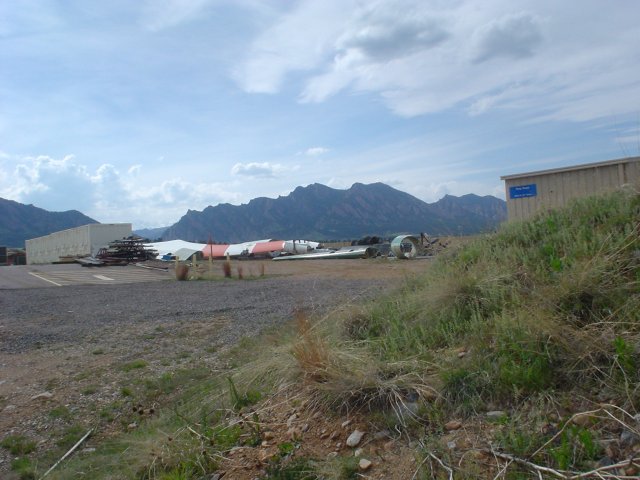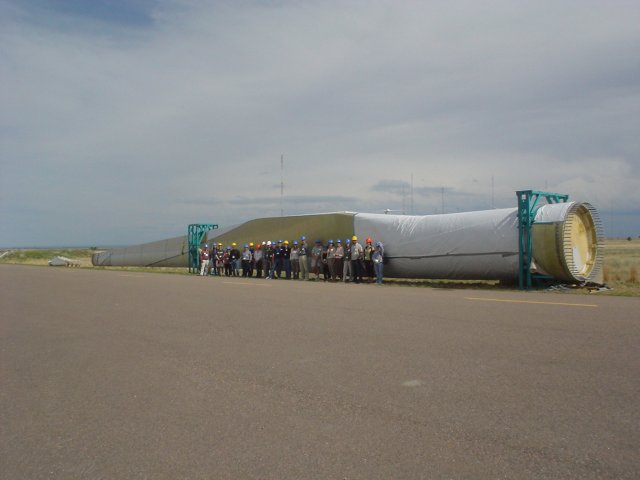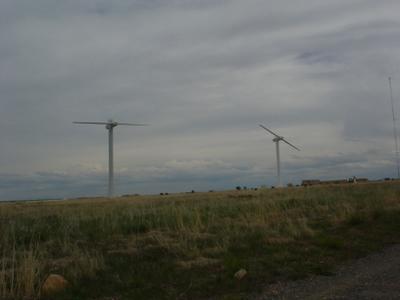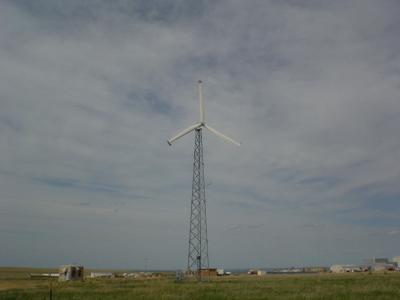And hopefully the expert NREL National Wind Technology Center staff will find it amusing that I'm waxing poetic about their boneyard first, and their turbines and facilities later! My apologies to Walter if I got any facts wrong, my mouth was hanging open too far to take notes.

Got a chip or nick in one of the 50-foot blades on your backyard wind turbine? Maybe you can make an offer -- though security is very tight here, and I don't think they admit folks who just show up at the gate and ask to do some "horse tradin'."

Tapered roller bearings on your hobby wind turbine getting squeaky? A little WD-40 and this puppy will be good as new. Just might fit the bill, as long as your project turbine has a 12 inch diameter shaft.

Is your old nacelle not dramatic enough? With a little fresh paint, this one will impress the neighbors. Would really spiff up the looks of your Air403, and ships on a standard 18-wheel tractor trailer.

Old blades from 20 to 100 feet long! Thousands of feet of lattice tower sections! Giant spools of guy wire and bins of cable clamps! Spools of power wires as thick as your arm! If the NREL NWTC ever has a garage sale, I'M THERE.

A whole crew of teachers who want to teach wind power to kids (I'm in there somwhere) .... in front of a 45 meter (148 foot) fiberglas composite turbine blade that weighs in at about 24,000 lbs. The whole day and tour courtesy of NREL and Michael at http://www.kidwind.org/ All these folks think that inspiring and teaching kids about wind power might make them want to pursue one of the dozen careers that relate to wind power. Plus, kids frankly find PV panels kinda' boring -- they just sit there -- but wind turbines are better than TV to watch. Notice the hard hats -- all OSHA regs here, folks. Safety glasses needed indoors. Hobbyists take note.

This 40+ meter blade has already been stress tested. All the pockmarks are from where strain gauges, laser sighting targets, wire harnesses and such were attached. The hydraulic machines in the blade testing building twist, bend, shake, vibrate and otherwise torture the blades, and computers record the data.
No pictures allowed inside the testing facilities, not beacuse of national security, but because NREL partners with the wind industry to test their stuff and there are trade secret concerns. No problem here in shutting off my camera after we entered the buildings, more power to these folks.
Write your congressmen and senators and ask them to cut some money loose for NREL to add a few feet onto the blade testing building. They've had to cut 2-3 feet off some blades that go in there because they were too long to fit in the building! I was amazed that the tip of a 45 meter blade was 1/8 inch thick, just like the ones we build. Of course the root is about 7 feet in diameter. Blades get bigger every year, and I think the NREL staff would really love to have a building that can fit them in there.
The dynamometer testing building was awesome, again no pics allowed. They were spinning up a 1500 kw (1.5mW) generator/gearbox/shaft assembly for accelerated stress testing, running it at over 2 mW (far over capacity) for 2000 hours. PC workstations control and monitor all aspects of the test---rpms, torque, temperatures, power in and out, vibration, even metal particle levels in the lubricating oil. The power produced is fed back into the dynamometer driver motor -- but friction losses are 200kW. Each computer has a little sign on it saying "Web surfing on this computer is absolutely forbidden." We did not see any Windows blue screens of death.

I think this 8kW Grumman Aerospace turbine from the 1970s must have sentimental value at NREL. It's the lawn ornament at the vistor's parking lot...much cooler than a pink flamingo.

The twins here are Advanced Research 600kW machines. Toys for big boys and girls at the the NWTC staff, they do research on control systems with them.

This one has a variable speed rotor, the other is constant speed. Variable speed is getting more common on utility-scale turbines.

Bergey 10kW that was zipping along the whole day we were there. All the numerous high lattice towers on the site are loaded with anemometers and lightning protection. They are everywhere! The Bergey feeds power into the NREL facility and the grid -- they actually have their own separate "mini grid" just for the small turbine testing area of the site, so they can simulate many different grid conditions, faults, etc. . But this bad boy was doing most of the power production all day:

This North Wind 100kW upwind was also producing power all day -- it's also a variable speed rotor. One teacher at the seminar was from Alaska and said they use this same turbine in many remote villages like Kotzebue and others -- revenues well spent by locals and tribes!

Atlantic Orient Corp 50kW downwind. If the turbine runs away, an internal cable shears and the flaps on the tips spring out to stop rotation so the repair crew can climb up.
Oh yeah, there was a Whisper and Bergey that power the guard house, they spun all day too. Cool, but BORING compared to what we'd seen!
All in all a VERY fun tour!
ADMIN